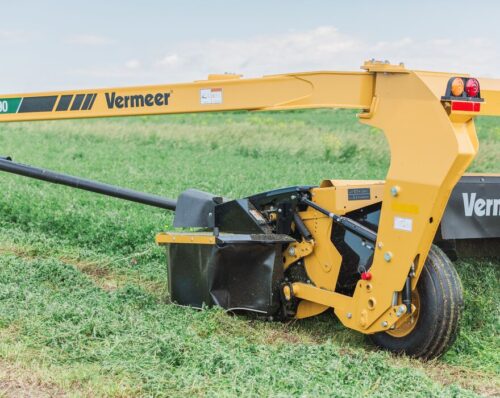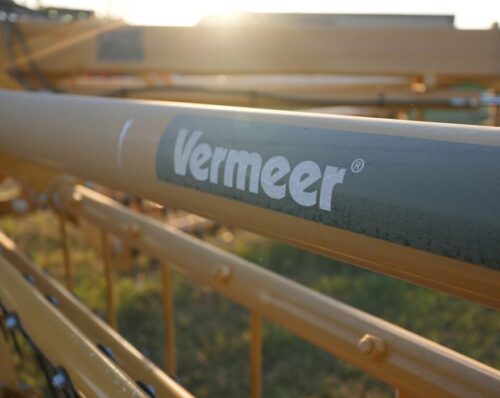
Balance Quality, Quantity to Help Your Hay Crop ‘Catch Up’
May 2018
Severe blizzards, drought and rangeland fires were major storylines for hay and forage producers and cattlemen in the months leading up to spring 2018, when alfalfa and other forage crops started their growth cycles for the year.
Those challenging conditions led to shortages of necessary feed sources for many livestock producers, causing them to purchase more hay than normal or seek alternative stocks to get their herds through the winter. That caused a spike in prices, with some types of hay selling for almost twice the normal price in late winter and early spring.
In its monthly Agricultural Prices report in late April, USDA showed its “all hay” price — an aggregate total of all forage types and quality — rose to $148/ton ($134.26/metric ton) by late March, a $5/ton ($4.54/metric ton) increase in one month that capped a $17/ton ($15.42/metric ton) increase over the previous year.
Challenging weather extremes
That rise was driven by a convergence of natural circumstances that left hay supplies well short of normal in many areas. In the 2017-2018 winter and spring alone, cattlemen in the Dakotas faced devastating blizzards while drought and rangeland fires decimated forages in parts of the central and southern Plains.
Other areas simply saw poor conditions that caused gradual forage quality deterioration. The combination of severe conditions in some areas and long-term poor growing conditions are responsible for the nation’s declining hay supplies, according to Gerald Lindquist, Michigan State University Extension educator and forage and grazing specialist.
“According to USDA surveys of farms conducted on Dec. 1, 2017, hay stocks in Michigan were down 16.7 percent from the previous year. Many Midwest states have experienced similar declines with Wisconsin being down 17.2 percent, Iowa down 14 percent, South Dakota down 10.8 percent and North Dakota down 28.7 percent,” Lindquist said in a university report. “Across the United States, total hay stocks are 10 percent lower than 2016 and are almost as low as what they were in the drought year of 2012.”
Forage demand rockets
The shortage led many cattle producers to reach the end of their supplies well before the end of the season for supplemental feeding. The resulting early-season rush left many — especially those in areas where the spring thaw was late to arrive — in a squeeze between tight supply and skyrocketing market prices.
“Those without hay continue to hope it happens really soon as finding anyone with hay and willing to part with it has been a difficult task lately,” according to a late-April hay market report from the Missouri Department of Agriculture. “Most years planting is well underway and grass is growing much faster than cattle can eat it but the late arrival of spring this year has made for a very long feeding season.”

Better hay, or more of it?
With such a short supply heading into this year’s growing season, producers have entered the warmer months under a lot of pressure to produce strong, vigorous crops to make up for the supply gap left by last year’s conditions around the country. But, it’s important to focus not only on basic tonnage, but also quality. Finding the right balance between quantity and quality should be a major priority for producers heading into their first and second cuttings this summer. That starts with timing your first and second cuttings, says University of Wisconsin-River Falls Assistant Professor of Forages and Extension Specialist Yoana Newman.
“Because we had a late start, consider cutting a little bit later than usual so you can compensate with tonnage. Delay the first and second cutting by maybe a week if you need more yield,” Newman says. “But, if you’re hard-pressed for quality, you may stick to your usual schedule. Find the right compromise for your operation between yield and quality.”
Researchers have decades of data showing the balance between tonnage and quality and the practices that can yield one over the other. Going back as far as the 1960s, University of Wisconsin researchers have found cutting height can be a major factor. If you need increased tonnage, it is possible to lower cutting heights without damaging the crop.
“Wisconsin studies conducted in the 1960s using vernal alfalfa showed that forages harvested three or four times per season produced more total forage when cut at a one-inch (2.5 cm) height versus cutting at three inches or more,” according to a University of Wisconsin Extension report by forage and cropping specialists Daniel Wiersma and Ron Wiederholt. “Recent North Dakota research evaluating the effects of cutting height shows similar results where shorter cutting height results in higher yields.”
But, if lowering cutting height, you may be sacrificing forage quality. It’s important to ensure you’re retaining necessary quality and not inflicting long-term damage to the perennial plants at the cost of production either later in the year or in future years.
“One of the reasons for leaving taller stubble is to improve the quality of harvested forage. The lowest sections of the alfalfa plant are typically higher in fiber and have fewer high-quality leaves present,” according to the report by Wiersma and Wiederholt. “If growers raise their cutting height to leave these high-fiber basal stem sections in the field, they may increase forage quality.”
Steps to balance quality and quantity

Determining which is more important between quantity and quality can be a challenge for some producers. There are basic steps to take to make it an easier decision in a year like 2018. Weed control and fertility are both important to a strong forage crop, but those should be tackled in a specific order, Newman says. It starts with weed control.
“In a year like this one when we had a late start to spring, you need to make sure you do all the practices to maximize your hay production. Weed control needs to be in place first, so you’re not being taken over by weeds,” she says. “I like to take care of weeds first, so your fields are clean.”
The second step in a “one-two punch” to help maximize early forage output is attention to fertility. Newman recommends waiting until after the first cutting before turning attention to soil nutrients.
“Between your first and second cuttings, make sure your fertility is in place. After the first cutting, conduct soil tests so you know what nutrients you may be short,” she says. “If you’re short on potassium, for example, make sure you apply it after the first cutting so you can compensate for the shortage in the second cutting.
“These steps will help you start to find the right compromise between yield and quality,” Newman adds.
This article contains third-party observations, advice or experiences that do not necessarily reflect the opinions of Vermeer Corporation, its affiliates or its dealers. Individual results may vary based on care and operation of machine and crop and field conditions, which may adversely affect performance.
Vermeer Corporation reserves the right to make changes in product engineering, design and specifications; add improvements; or discontinue manufacturing or distribution at any time without notice or obligation.
Vermeer, the Vermeer logo and Equipped to Do More are trademarks of Vermeer Manufacturing Company in the U.S. and/or other countries.
© 2018 Vermeer Corporation. All Rights Reserved.






